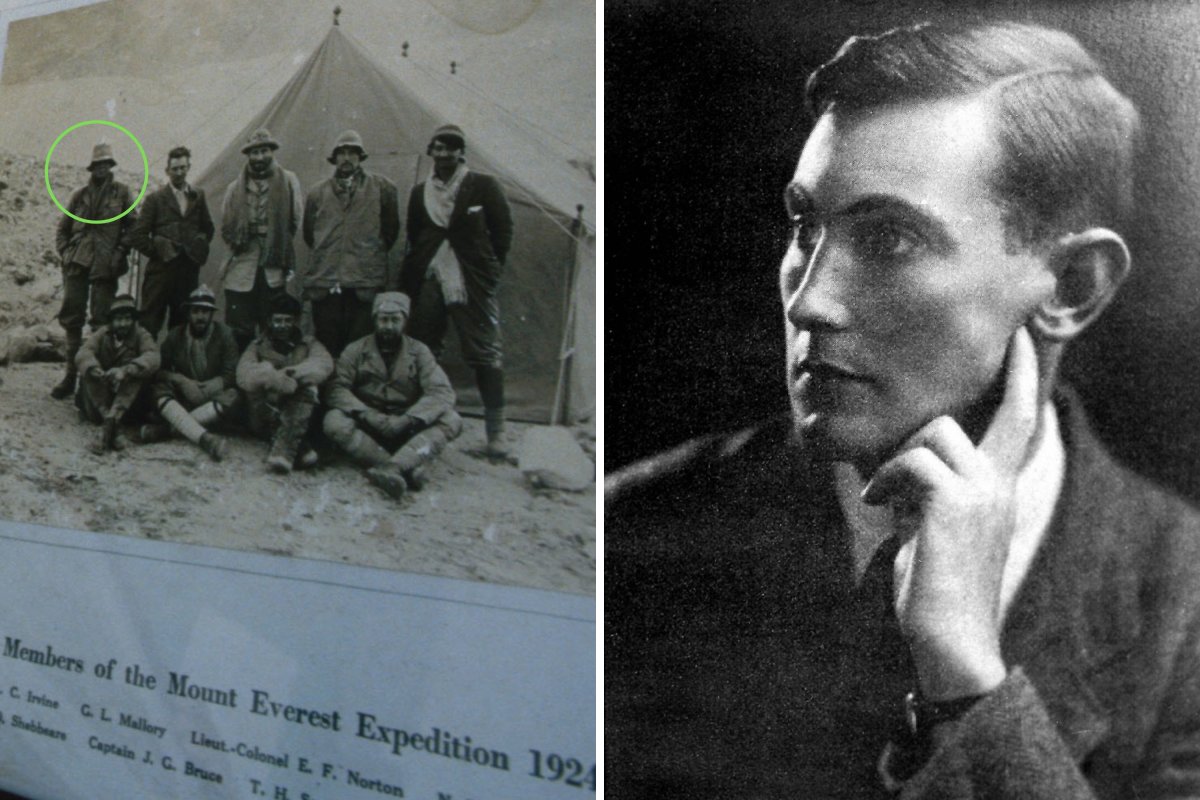The body of one of the hikers in Mount Everest’s greatest mystery is believed to have been found after 100 years.
British mountaineer Andrew “Sandy” Irvine vanished alongside fellow climber George Mallory in 1924 as the pair attempted to become the first to summit the world’s highest mountain. Whether they succeeded remains a mystery.
Speculation has long persisted as to whether Mallory and Irvine made it to the top of Everest. If they did, they would have beaten the first acknowledged summit of the mountain, by Sir Edmund Hillary and Tenzing Norgay in 1953, by 29 years.
Last month, a National Geographic documentary team discovered a worn leather boot peeking out of the ice on the Central Rongbuk Glacier, below the north face of Everest. In the boot they found the remains of a foot and a sock with a label reading “A.C. IRVINE” stitched onto it.

Andrew Irvine (circled at left) and George Mallory (to the right of Irvine) are pictured during the 1924 British Mount Everest expedition. At the right is an undated photograph of Mallory. The suspected remains of Irvine were recently discovered by a National Geographic team below Everest’s north face.
John van Hasselt/Getty Images
Members of Irvine’s family have offered to share DNA samples to compare with the remains of the foot in the hopes of ascertaining whether the remains really are Irvine’s.
Photographer and director Jimmy Chin, who was among the group, said the team realized the significance of the moment immediately.
“We were all literally running in circles dropping f-bombs,” he told National Geographic.
Newsweek has emailed the National Geographic press office for further comment.
Speaking about the discovery, Chin said, “It’s the first real evidence of where Sandy ended up. A lot of theories have been put out there.”
He also hopes the discovery might bring some closure to Irvine’s relatives.
“When someone disappears and there’s no evidence of what happened to them, it can be really challenging for families,” he said. “And just having some definitive information of where Sandy might’ve ended up is certainly [helpful] and also a big clue for the climbing community as to what happened.”
As a result, one of the first people Chin contacted after finding the remains was Julie Summers, Irvine’s great-niece. Summers wrote a biography of Irvine in 2001 and said of the latest discovery: “It’s an object that belonged to him and has a bit of him in it. It tells the whole story about what probably happened.”
Days before the National Geographic team came across the boot, they found an oxygen canister marked with the date 1933. The 1933 expedition to summit Everest had also failed, but the hikers did find an ax that belonged to Irvine on the northeast ridge of the mountain.
Chin says the discovery of the oxygen canister got the team to thinking that Irvine may have fallen down the north face of the mountain. The team began looking, and eventually climber Erich Roepke spotted the boot.
Mallory’s remains were discovered in 1999 by alpinist Conrad Anker, who was part of the Mallory and Irvine Research Expedition, which sought to determine whether Mallory and Irvine had reached the summit before they died.
When examined, Mallory’s remains had deep rope marks that appeared to suggest his fall was caught by a rope wrapped around his waist.
The discovery of Mallory’s body raised questions about whether he and Irvine had summited the mountain. Mallory’s dark snow goggles were in his pocket, which suggested that he had fallen in the evening when descending.
Also, a photo of his wife, which Mallory had planned to leave at the top of Everest, was nowhere to be found on his person.
The specific location of Irvine’s suspected remains has not been revealed. However, the Central Rongbuk Glacier, where they were found, is at least 7,000 feet lower than where Mallory’s remains were located.
It is thought that Irvine was carrying a Kodak camera, and its photos could prove whether he and Mallory reached the summit of the 29,030-foot mountain. However, a camera was not found with the boot.
The China Tibet Mountaineering Association, which is responsible for issuing permits on Everest’s northern side, has possession of the recently discovered remains.





